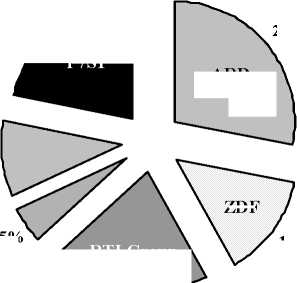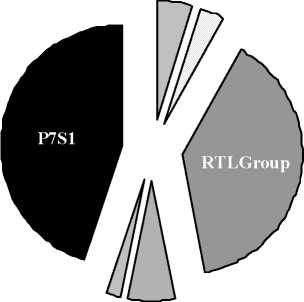Budzinski/Wacker: Springer-ProSiebenSat.1-Merger
ers with considerable fringe competition, the TV advertising market is dominated by
two private TV-networks (P7S1 and RTLGroup). Public television (ARD and ZDF)
attracts more than 40 % of the overall audience but is restricted concerning its offer-
ing on the advertising market due to its character as predominantly financed through
public fees. As a consequence, the TV advertising market shows a duopoly by P7S1
and the RTLGroup, each representing a 45 % market share. The RTLGroup is a sub-
sidiary of Bertelsmann, the major media company in Germany and one of the largest
world-wide. Besides the RTLGroup, other major subsidiaries of Bertelsmann are
Random House (books), SonyBMG (music) and Gruner+Jahr (magazines).1 Together
with AS, Bertelsmann (via Gruner+Jahr) is engaged in the rotogravure company Pri-
novis. Apart from its pre-merger share in P7S1, AS is no considerable player on the
TV market.2
Figure 1: TV Audience and TV Advertising Market Shares in 2004
Audience Share 2004
Advertising Market Share 2004
22%
28%
P7S1
Others
10%

ZDF
14%
5%
RTL II
RTLGroup
21%
ARD
ARD
5%
ZDF
3%
45%

39%
2% 6%
Others RTL II
ARD includes regional stations (“Dritte Programme”).
Source: Compiled from Bundeskartellamt (2006).
Instead, AS core competence is the newspaper market, where the AS product “BILD-
Zeitung”, Germany’s leading daily boulevard newspaper, stands out. As newspapers
are not distributed freely, both the newspaper reader market and the newspaper adver-
tising market are relevant. Concerning the reader market, the Bundeskartellamt (2006:
1 Gruner+Jahr publishes numerous weekly and monthly magazines, the most well-known of which is
STERN. Via Gruner+Jahr Bertelsmann also has an interest in the SPIEGEL Verlag.
Additionally, AS holds a 27% share in “Hamburg 1”, a regional TV station with negligible market
shares.
More intriguing information
1. Has Competition in the Japanese Banking Sector Improved?2. Fighting windmills? EU industrial interests and global climate negotiations
3. Three Policies to Improve Productivity Growth in Canada
4. STIMULATING COOPERATION AMONG FARMERS IN A POST-SOCIALIST ECONOMY: LESSONS FROM A PUBLIC-PRIVATE MARKETING PARTNERSHIP IN POLAND
5. AGRICULTURAL TRADE LIBERALIZATION UNDER NAFTA: REPORTING ON THE REPORT CARD
6. The name is absent
7. Smith and Rawls Share a Room
8. The name is absent
9. Putting Globalization and Concentration in the Agri-food Sector into Context
10. Subduing High Inflation in Romania. How to Better Monetary and Exchange Rate Mechanisms?